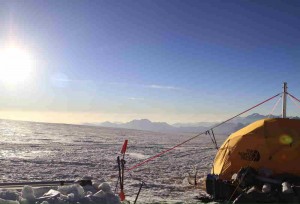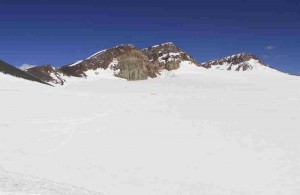Ice Core Drilling and Return: Blog Five
Click here to see all Climate Change blog entries.
The last two weeks have been extremely busy and productive. In the last blog entry we were about to leave for the 18,270-foot camp. We headed up on Feb. 1 and although we had waited for a break in the winds we were met by some strong gusts. The camp site was situated on a large, steep, sandy bank next to the glacier, which provided us with an excellent vantage point to plan trips onto the ice. There were hardly any rocks available so the tents had to be fastened with sand bags.

Once we had our shelters built and had set up our stove to begin melting snow for drinking water, our first priority was to get the snowmobile put together. We designated our kitchen tent as the construction site. Francisco and Masetta did a fantastic job, managing to finish in two days while working with limited space and in sub-zero temperatures. During this time the rest of the team was working on finding a safe route to the drill site. We were surprised to find many more crevasses on the way to the site than last year. For recreational travel across a glacier this is not a problem, a team just needs to be roped and will most likely only cross individual crevasses once or twice. In our case, we were planning on carrying heavy equipment with a snowmobile many times across the glacier. Due the multitude of crevasses and the uncertainty of how the snow bridges would hold up, we opted to change our drill to a safer and closer location. The new drill site was of the same quality as the original site; however, the ice core would be a bit shorter – a small price to pay for the safety of our team members.
The snowmobile worked perfectly, making the transportation of our gear much easier. We fastened 3 sleds together and attached them behind the snowmobile. What would have taken us days to prepare and carry to the drill site took only hours. We also used the snowmobile as a fast and fun way to commute to work. Before we could begin drilling we had to set up the drill tent, build the drill itself and dig a trench (with a chain-saw) to store the ice cores in. Although the glacier is cold, direct sunlight at these altitudes can heat surfaces, so it’s best to cover the ice cores during the day.

We began drilling on Feb. 4. Drilling is as much an art as a technical skill and we were very lucky to have Mike as our driller. He has a vast amount of experience, having drilled all around the world. In addition to retrieving cylindrical ice segments from the glacier and storing them, the ice cores also needed to be examined for particular ice properties, such as summer melt layers. We always handled the ice cores carefully and cleanly, wearing clean suits, masks, and gloves. We use clean suits because we do not want to possibly contaminate the chemistry of the ice, although we actually only use the outside of the ice core to measure stable water isotopes, a possible temperature indicator that can reveal warmer vs. colder time periods, which cannot be contaminated by handling the ice. We use the inner part of the core, which never comes into contact with the drill or handlers, for major soluble ions and trace elements, such as sodium, sulfate, and lead. These types of chemical species can be indicators of natural and/or anthropogenic sources. Our job when we get back to Maine is to see how the ice chemistry has changed as we move from the top of the core (the present time) to the bottom (the past). Overall the drilling went very smoothly and we finished on Feb. 7. As expected, the ice core at the new site was shorter, reaching a depth of 200 feet.
Now that we had the ice core, the difficult task of transporting it frozen and intact back to Santiago had begun. Our plan was to have the mules carry the ice in insulated boxes down to Aqua Azul camp where they would be repacked with dry-ice to maintain sub-zero temperatures for the rest of the trip. Paul took a test trip with ordinary ice down first to make sure every thing was in place for transfer. This included the delivery of dry ice, access to a freezer truck at the trailhead, and open roads to the Santiago freezer. Once Paul reported the test had been a success, we packed the ice cores and sent them down the mountain. Michael accompanied the ice cores to Santiago and reported last night that the ice was safely sitting in a freezer. It was extremely relieving to hear that the ice was safe. During the last couple years the team, led by Paul, has worked very hard to recover this ice.
Andrei, Mariusz, Masetta, and I traveled down from the glacier yesterday and are currently staying at the Agua Azul camp. We will remain here a couple more days to wait for our equipment, which the Arrieros will take down from the glacier.
